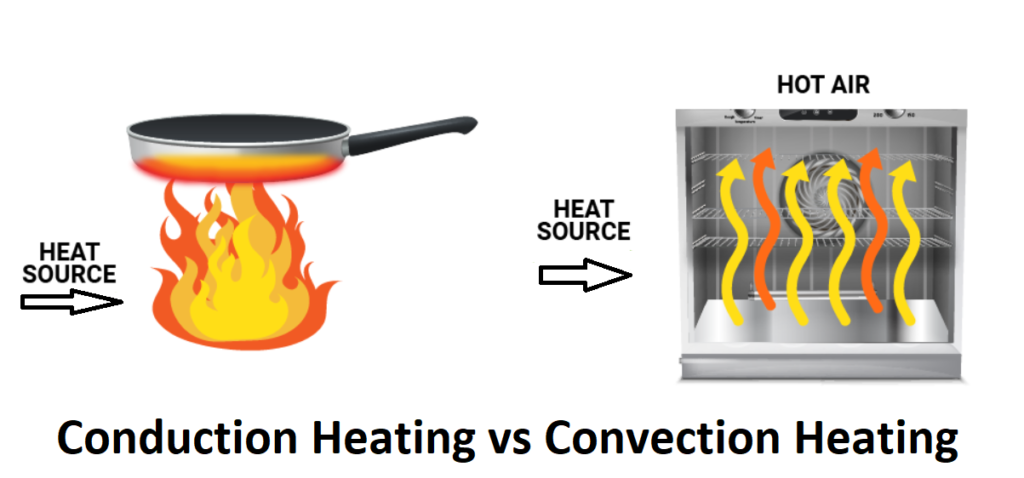Conduction vs Convection Heating in Vaping Devices
There are numbers of things to consider while shopping the vape for yourself. Each vape enthusiast sees different things, including portability, heat-up times, and device compatibility with the concentrate or herbs. But there is one more thing which is very important to consider while buying: the heating system. Let’s find out the key differences between conduction and convection vaporizers so you can make an informed decision.

Table of Contents
Conduction vaporizer
Have you ever used the conduction vaporizer? If not, no problem! Let’s walk you through the cooking analogy. The conduction transmits the heat through direct contact with the heating element. People use conduction when cooking food and putting the ingredients in a hot frying pan. However, in the vapes context, the herbs come directly in contact with a heating element to expose the bud to high temperatures of vaporizer cannabinoids and terpenes.
Many vape enthusiasts have made the switch to different heating systems i.e. conduction and convection vaporizers. At the same time, many remain loyal to conduction devices, and some new models continue to come with these heating systems, including the following;
Boundless CF
The Boundless CF has a sleek look with amazing performance. The device handles the dry herbs and concentrates using conduction heating in just 20 seconds. The chamber size of 0.5g and pocket-sized body makes it one of the best conduction devices at home and on the go!
Airvape XS Go
Airvape XS Go has taken portability to a new level. If you like to vape while you are busy or on the go, XS GO! It should be your choice. With conduction technology, the device heats the material in 10-30 seconds, providing a smooth experience to vape enthusiasts.
Convection Vaporizer
The convection process uses heat transfer to heat the herbs and concentrates and turn the solid material into smoke clouds. But how does convection work? For this method, the material is not placed in direct contact with the heating element, but the circulating air is used to push the heat away from the heating element. Convection heating uses the same method. So, the device uses the air to move the heat from the separate elements to the herbs.
Vaporizers’ continuous update in the vape market has allowed users to enjoy their herbs and concentrates completely. While looking for the vapes, the users can see that conduction vaporizers came about first. However, the convection devices soon caught up and surged in popularity because of people’s personal preferences. Here are two big examples of successful convection vaporizers.
Utillian 620
Utillian keeps releasing budget-friendly vaporizers. The latest release is the Utillian 620 with a good convection heating design. It carries the features of fan-favorite Utillian 421 and Utillian 722, except it features the magnetic mouthpiece for easy loading, a built-in stir tool, and a new form of heating called helix heating, making a convection fun experience for vape enthusiasts.
Firefly 2+
Firefly vaporizers are among the best portable vaporizers on the market. The Firefly 2+ looks like the predecessor’s reincarnation. Overall, the Firefly 2+ is a portable convection vaporizer that features all the Firefly 2 qualities with many improvements for a better vaporizing experience. The Firefly 2+ comes with convection heating and a powerful, rechargeable, and replaceable 7.4volt lithium-ion battery that takes only 45 minutes to charge using a USB Cable fully. The user can select a temperature from 320°F to 420°F in 20° increments. Also, the device is compatible with the smartphone app, making vaping more fun.
Pros and Cons of Conduction and Convection Vaporizer
Both heating methods (conduction and convection vaporizers) have pros and cons, so choosing one method depends on what matters to you most.
Conduction Vaporizers
Pros
- Smaller footprint
- Battery lasts longer
- Good vapor quality
- Simpler to use
Cons
- Slight possibility of uneven vaporization
Overall, the conduction vaporizers are less efficient as the dry herbs do not touch the heat elements directly, so the herbs are unevenly vaporized. However, this can be fixed by ensuring each part of the dry hen gets an equal heat distribution so that quality can be achieved.
The vapor quality of good. However, if the user stirs the dry herbs during the session, it will make sure that essential oils from the herbs are extracted, and the quality session is maintained. Also, they don’t use much space to generate heat, so they are generally smaller than convection units.
Conduction units are smaller and simpler to use. As a result, they use efficient use of energy and generate longer use before the battery needs a recharge.
Convection Vaporizer
Pros
- Good vapor quality
- Better flavor
- Better Airflow
Cons
- Big device
- Expensive Device
- Harder to use
- The battery doesn’t last as long as Conduction Vapes
Overall, the convection vaporizers are tricky to use, but the good thing about them is the better vapor quality and flavor. These two are the primary demands of vape enthusiasts.
Convection vaporizers are responsible for a larger footprint as they need extra space to generate the hot air, resulting in a higher battery energy cost. Moreover, they are more expensive as compared to conduction vaporizers.
Which Vaporizer should you Buy?
It all comes down to personal preference. Every vape offers a lot of incentives and settings that make people consider them personal vaping devices. For example, conduction vapes are attractive to people who still love to smoke because of the bigger cloud and offers similar experience as smoking. On the other hand, convection vapes offer smooth clouds and reduce the risk of combustion. However, if you still can’t choose between the two, the user can settle for the hybrid vape. These hybrid models use both heating systems and offer the best of both worlds.


